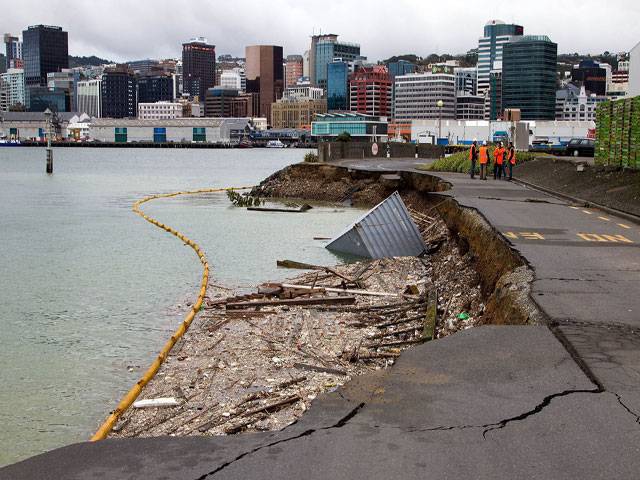WELLINGTON : Emergency crews launched a major clean-up Monday following a 6.5-magnitude earthquake in Wellington, as aftershocks continued to rattle the New Zealand capital.
The powerful tremor sent masonry and glass crashing into downtown streets on Sunday evening, with panicked locals running for cover amid fears the quake-prone city was finally experiencing "the big one".
Authorities said that while the seismic jolt caused buildings to crack and a section of road near the harbour to fall into the sea, most of the damage appeared "superficial rather than structural".
Mayor Celia Wade-Brown said there were only four reports of minor injuries and the capital appeared to have emerged relatively unscathed from the quake, which occurred when the central business district was largely empty.
"We're very grateful that that's how we've come out of quite a significant earthquake," she told reporters.
Some areas of the city were cordoned off as emergency workers removed debris and the streets were eerily quiet, with office workers heeding calls to stay at home.
However, nerves remained frayed in New Zealand, where a devastating tremor two years ago killed 185 people in the main South Island city of Christchurch.
Experts said it was a lucky escape for the capital, which lies near five major fault lines.
The quake struck at 5:09 pm (0509 GMT) on Sunday at a depth of 14 kilometres (8.6 miles) and was followed minutes later by a 5.5-magnitude aftershock, the US Geological Survey said.
Seismologist Stephen Bannister, from the official GeoNet monitoring service, said its epicentre was about 57 kilometres outside Wellington, while the Christchurch quake was felt more intensely because it took place less than five kilometres from the city.
"If it had been under the city we would have been looking at equal damage or close to what happened in Christchurch," Bannister told Fairfax Media.
He said there had been more than 100 aftershocks since Sunday's quake and there was a one-in-five chance of another tremor measuring 6.0 or above in the next week.
But Bannister said it was impossible to predict whether the seismic activity was a precursor to a larger quake that would cause major disruption, adding "a big one can happen at any time".
Prime Minister John Key said he did not expect a major damage bill from the quake and was more concerned about its psychological impact on Wellington's population.
"I worry about the mental impact on Wellingtonians, just the fear factor," he told TVNZ.
"People have high levels of anxiety in earthquakes, that's totally understandable, they feel helpless, they can't control the situation."
Wellington was the scene of the country's most powerful earthquake in 1855.
That 8.2 magnitude-quake caused four deaths and changed the city's entire geography, pushing the shoreline out 200 metres (660 feet) as it thrust the harbour floor upwards.
New Zealand is on the boundary of the Australian and Pacific tectonic plates, forming part of the so-called "Ring of Fire", and experiences up to 15,000 tremors a year.
Friday, April 19, 2024
New Zealand cleans up after strong 6.5 quake

9:58 PM | April 18, 2024
Hepatitis Challenge
April 18, 2024
IMF Predictions
April 18, 2024
Wheat War
April 18, 2024
Rail Revival
April 17, 2024
Addressing Climate Change
April 17, 2024
Justice denied
April 18, 2024
AI dilemmas unveiled
April 18, 2024
Tax tangle
April 18, 2024
Workforce inequality
April 17, 2024
New partnerships
April 17, 2024
ePaper - Nawaiwaqt
Advertisement
Nawaiwaqt Group | Copyright © 2024





